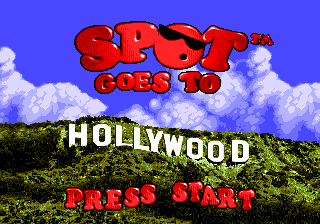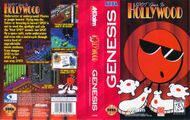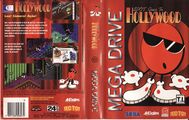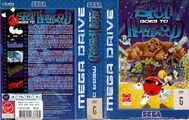Spot Goes to Hollywood
From Sega Retro
- For the Sega Saturn game, see Spot Goes to Hollywood (Saturn).
| Spot Goes to Hollywood | ||||||||||||||||||||||||||||||
|---|---|---|---|---|---|---|---|---|---|---|---|---|---|---|---|---|---|---|---|---|---|---|---|---|---|---|---|---|---|---|
| System(s): Sega Mega Drive | ||||||||||||||||||||||||||||||
| Publisher: Virgin Interactive (EU), Acclaim Entertainment (NA) | ||||||||||||||||||||||||||||||
| Developer: Eurocom | ||||||||||||||||||||||||||||||
| Sound driver: GEMS | ||||||||||||||||||||||||||||||
| Genre: Action | ||||||||||||||||||||||||||||||
| Number of players: 1 | ||||||||||||||||||||||||||||||
| ||||||||||||||||||||||||||||||
Spot Goes to Hollywood is an isometric sequel to Cool Spot. It was developed by Eurocom and published by Virgin Interactive in Europe and Acclaim Entertainment in North America in 1995 for the Sega Mega Drive. A Sega 32X game, again slightly different from the aforementioned versions was planned, though was cancelled mid-way through development.
Significantly enhanced versions with different levels appeared on the Sega Saturn and PlayStation in 1997. These versions were developed by Burst.
During development the game was known as Cool Spot 3[3].
Contents
Story
7-Up mascot, Spot has become trapped within a movie projector, and must now travel between different movie genres attempting to escape (and rescue other spots, similar to Cool Spot).
Unlike previous Spot games, the 7 Up beverage is not referenced at any point in Spot Goes to Hollywood (aside from in copyright details). This is in contrast to Cool Spot which had its bonus stages set within giant 7 Up bottles, and frequently made nods to the drink (though much of this was censored in the PAL version of the game).
Gameplay
Spot Goes to Hollywood plays much the same as Cool Spot, however presents its gameplay in an isometric perspective, allowing for pseudo-3D gameplay. Levels are still linear in design, although this change in style leads to gameplay being more about shooting than precise platforming.
As the game takes place in a fictional (from Spot's perspective) world, it is not designed with spot's small size in mind.
Production credits
Mega Drive version
- Developed by: Eurocom Entertainment Software
- Lead Programmers: Ian Denny, Tim Swann
- Additional Programming: Steve Bak, Ashley Finney, Kevin Grantham, Tim Rogers
- Art and Animation: Andy Bee, Matt Dixon, Colin Garratt, Adrian Mannion, Clive Stevenson
- Additional Art: Nigel Bentley, Pete Lyon
- Project Management: Hugh Binns, Tim Rogers, Mat Sneap
- Tools Programming: Nick Flemming, Tim Rogers
- Maps and Level Design: Steve Bak, Hugh Bins, Ian Denny, Steve Duckworth, Colin Garratt, Kevin Grantham, Adrian Mannion, Mat Sneap
- Music and Sound: Tommy Tallarico
- Testing: Kevin Holt, Richard Moody, Libby Whitham
- Special Thanks to: Martin Alper, Richard Alton, Neil Baldwin, Paul Bates, David Fries, Mark Hetherington, Stuart Johnson, Nick Jones, Dave Looker, Dave Perry, Dave Pridmore, Julian Rignall, Ren Rosman, Rob Watkins, John Williams, Neil Young
- Published by: Virgin Interactive Entertainment
- Producer: Robb Alvey
- Associate Producer: Grady Hunt, Mike Merrin
- Assistant Producer: Craig McCoy
- Vice President Production: Erix Lux
- Q.A. Manager: Dave Maxey
- Group Head: Stacey Mendoza
- Lead Analyst: Gordon Madison
- Anaylsts: Jeff Rice, Mitch Feldman, Paul Shoener, David E. Johnson, Brian Wagner, Matt Muench, Victor Rodriguez, Robert Dearborn
Magazine articles
- Main article: Spot Goes to Hollywood/Magazine articles.
Promotional material
Physical scans
Mega Drive version
| Sega Retro Average | ||||||||||||||||||||||||||||||||||||||||||||||||||||||||||||||||||||||||||||||||||||||||||||||||||||||||||||||||||||||||||||||||||||||||||||||||||||||||||
|---|---|---|---|---|---|---|---|---|---|---|---|---|---|---|---|---|---|---|---|---|---|---|---|---|---|---|---|---|---|---|---|---|---|---|---|---|---|---|---|---|---|---|---|---|---|---|---|---|---|---|---|---|---|---|---|---|---|---|---|---|---|---|---|---|---|---|---|---|---|---|---|---|---|---|---|---|---|---|---|---|---|---|---|---|---|---|---|---|---|---|---|---|---|---|---|---|---|---|---|---|---|---|---|---|---|---|---|---|---|---|---|---|---|---|---|---|---|---|---|---|---|---|---|---|---|---|---|---|---|---|---|---|---|---|---|---|---|---|---|---|---|---|---|---|---|---|---|---|---|---|---|---|---|---|
|
| 78 | |
|---|---|
| Based on 30 reviews | |
Unreleased versions

|
| Spot Goes to Hollywood |
|---|
| System(s): Sega 32X |
A version of the game for the Sega 32X was in development around the same time as the Mega Drive version. It would have featured more detailed prerendered graphics, as well as a 3D Space Harrier-style bonus stage. The bonus stage was not used in the later Saturn version.
References
- ↑ 1.0 1.1 1.2 1.3 File:SSM UK 01.pdf, page 86 Cite error: Invalid
<ref>tag; name ":File:SSM UK 01.pdf_p86" defined multiple times with different content - ↑ 2.0 2.1 File:GamePro US 080.pdf, page 62 Cite error: Invalid
<ref>tag; name ":File:GamePro US 080.pdf_p62" defined multiple times with different content - ↑ File:Mega UK 22.pdf, page 7
- ↑ 4.0 4.1 File:Hyper AU 023.pdf, page 50 Cite error: Invalid
<ref>tag; name ":File:Hyper AU 023.pdf_p50" defined multiple times with different content - ↑ 5.0 5.1 File:MeanMachinesSega37UK.pdf, page 22 Cite error: Invalid
<ref>tag; name ":File:MeanMachinesSega37UK.pdf_p22" defined multiple times with different content - ↑ 1700 igr dlya Sega, "" (RU; 2001-xx-xx), page 221
- ↑ Consoles +, "Décembre 1995" (FR; 1995-1x-xx), page 108
- ↑ Cool Gamer, "9" (RU; 2002-10-13), page 204
- ↑ Digitiser (UK) (1996-01-25)
- ↑ Electronic Gaming Monthly, "February 1996" (US; 1996-xx-xx), page 31
- ↑ Entsiklopediya luchshikh igr Sega. Vypusk 1, "" (RU; 1999-xx-xx), page 361
- ↑ Entsiklopediya luchshikh igr Sega. Vypusk 4, "" (RU; 2001-xx-xx), page 257
- ↑ Game Players, "Vol. 9 No. 3 March 1996" (US; 1996-0x-xx), page 64
- ↑ GamePro, "December 1995" (UK; 1995-10-28), page 42
- ↑ Hobby Consolas, "Enero 1996" (ES; 199x-xx-xx), page 54
- ↑ Joypad, "Décembre 1995" (FR; 1995-1x-xx), page 66
- ↑ LeveL, "Únor 1996" (CZ; 1996-02-07), page 21
- ↑ LeveL, "Únor 1997" (CZ; 1997-02-01), page 86
- ↑ MAN!AC, "12/95" (DE; 1995-11-08), page 65
- ↑ Mega Fun, "12/95" (DE; 1995-11-21), page 40
- ↑ Player One, "Janvier 1996" (FR; 199x-xx-xx), page 98
- ↑ Power Up!, "Saturday, January 06, 1996" (UK; 1996-01-06), page 1
- ↑ Power Unlimited, "Jaargang 4/April 1996" (NL; 1996-0x-xx), page 30
- ↑ Sega Magazin, "Januar 1996" (DE; 1995-12-13), page 16
- ↑ Sega Power, "January 1996" (UK; 1995-11-16), page 50
- ↑ Sega Pro, "January 1996" (UK; 1995-11-30), page 32
- ↑ Svet Kompjutera, "Septembar 1996" (YU; 1996-xx-xx), page 79
- ↑ Sega Megazone, "Summer '95/'96" (AU; 1995-xx-xx), page 39
- ↑ Todo Sega, "Enero 1996" (ES; 199x-xx-xx), page 30
- ↑ Tricks 16 bit, "Tricks Sega Gold 800 igr" (RU; 1998-03-20), page 25
- ↑ Video Games, "12/95" (DE; 1995-11-21), page 72
- Pages with reference errors
- 1 player games
- US Mega Drive games
- EU Mega Drive games
- PT Mega Drive games
- AU Mega Drive games
- BR Mega Drive games
- Mega Drive games
- 1995 Mega Drive games
- All 1995 games
- Mega Drive action games
- Old content rating field
- Use romtable template
- All games
- Credits without source
- Credits without reference
- GalleryPrintAd file defined
- Old-style rating (consolesplus)
- Rating without PDF source
- Old-style rating (digitiser)
- Rating without source
- Old-style rating (egm)
- Old-style rating (gameplayers)
- Old-style rating (gamesmaster)
- Old-style rating (hyper)
- Use magref
- Old-style rating (joypad)
- Old-style rating (maniac)
- Old-style rating (mms)
- Old-style rating (playerone)
- Old-style rating (pu)
- Old-style rating (segapower)
- Old-style rating (segapro)
- Old-style rating (ssm)
- Update ratings template
- 14 old ratings
- No title screen
- Unreleased 32X games
- All unreleased games






